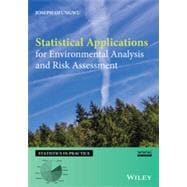Statistical Applications for Environmental Analysis and Risk Assessment guides readers through real-world situations and the best statistical methods used to determine the nature and extent of the problem, evaluate the potential human health and ecological risks, and design and implement remedial systems as necessary. Featuring numerous worked examples using actual data and “ready-made” software scripts, Statistical Applications for Environmental Analysis and Risk Assessment also includes:
• Descriptions of basic statistical concepts and principles in an informal style that does not presume prior familiarity with the subject
• Detailed illustrations of statistical applications in the environmental and related water resources fields using real-world data in the contexts that would typically be encountered by practitioners
• Software scripts using the high-powered statistical software system, R, and supplemented by USEPA’s ProUCL and USDOE’s VSP software packages, which are all freely available
• Coverage of frequent data sample issues such as non-detects, outliers, skewness, sustained and cyclical trend that habitually plague environmental data samples
• Clear demonstrations of the crucial, but often overlooked, role of statistics in environmental sampling design and subsequent exposure risk assessment.








